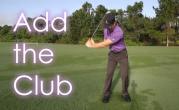Video Menu
My Favorite Videos
My Favorite Videos
Intro - Add the Golf Club
Sorry, you need to be a member to access this video.
You Are Just Seconds Away - Become a member here!
Already a member? Log in now

Now it's time to add the golf club into your swing drills. This step will come easily if you've mastered the first three steps.
okay so now as we get to the fourth step of the RST five-step system is time to add the golf club now as you're working on your golf swing you can still keep playing and all of those things and still obviously be hitting balls and stuff but if you're really serious about working on your swing when you're doing the drills when you're trying to make real improvements you're not just out pounding balls it should take a while for you to get into this to this fourth step it should take months before you're really worrying about what the club is doing throughout the whole swing you really have to focus on the fundamentals first and the fundamentals are as you should know this by now if you watch the video on fundamentals they have to be central origin absolute primary the primary movements the central movements are coming from the center of your body so the movements of the club are a consequence and dependent of what your body does and what your lead arm does and what your weight shift does so really when you get to the four step and you start adding this golf club the club should start just kind of going exactly where you want it to do if you wanted to be here in the takeaway well all i did is shift my weight and rotate my core i didn't do anything with my hands as i go to the top it's going to be there because i move my body correctly as i come down i create lag because i shifted my weight and so on so as you go through this next series of videos you should find that adding the club and getting the club into the right position should be very easy if it's not you're probably not moving your body correctly so this next step shouldn't be that hard you can start to get the club into more detailed positions and so on but the key is to really still make sure that you're still ingraining this movement of your core driving the golf swing that's your primary mover and the golf club is just moving as a result of how you move from the center




































































































































































































































































































































































































































































































Greg
Craig (Certified RST Instructor)
Matthew
Michael (Certified RST Instructor)
Matthew
Michael (Certified RST Instructor)
Matthew
Michael (Certified RST Instructor)
Mathew
Craig (Certified RST Instructor)
Matthew
Craig (Certified RST Instructor)
Todd
Craig (Certified RST Instructor)
John
Craig (Certified RST Instructor)
John
Craig (Certified RST Instructor)
John
Craig (Certified RST Instructor)
William (Certified RST Instructor)
Craig (Certified RST Instructor)
William (Certified RST Instructor)
Craig (Certified RST Instructor)
William (Certified RST Instructor)
Craig (Certified RST Instructor)
William (Certified RST Instructor)
Rich
Craig (Certified RST Instructor)
Rich
Craig (Certified RST Instructor)
Rich
Craig (Certified RST Instructor)
Steve
Craig (Certified RST Instructor)
Steve
Craig (Certified RST Instructor)
Steve
Steve
SIMON
Dean
mark
Craig (Certified RST Instructor)
mark
Craig (Certified RST Instructor)
LANDON
Chris (Certified RST Instructor)
John
Craig (Certified RST Instructor)
Jim
Craig (Certified RST Instructor)
Jim
Jim
Craig (Certified RST Instructor)